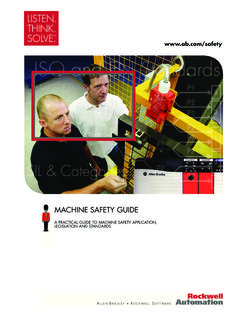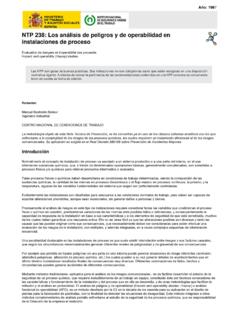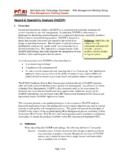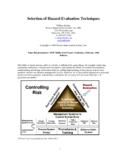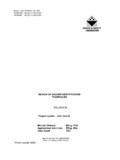Transcription of A5 Safety Cat CH4 - BARA
1 Chapter 473 Risk AssessmentRisk to risk a risk 474 Risk Assessment75 Risk Background to risk assessmentMachinery must be safe to use, and the best way to achieve this isthrough good design and proper working practices. The regulationsemphasize the need to assess the machine s risk, both in its designstage and in its application. Different types of machine have differentlevels of associated risk. These risk levels must be determined at thedesign stage, so that any improvements necessary to the mechanicaland electrical design of the machine can be identified, enabling it tomeet the requirements of the regulations. In simple terms, there are only 2 real factors to consider:The severity of foreseeable injuries (ranging from a bruise to a fatality)The probability of their is very little that can be done about the severity of injury,should anyone happen to come into contact with moving parts, butmuch can be done to reduce the probability of contact 292 Parts 1 and 2 ( Safety of machinery.)
2 Basic concepts, generalprinciples for design) lists the main forms of hazards arising frommachinery and requires that these be protected against. Itrecommends two approaches, which can be used separately or intandem. Firstly, the designer must look carefully at the initial design of themachine to assess the potential for avoiding or reducing as manyhazards as possible. This can be achieved by selecting suitabledesign features. Secondly, the designer must look at the possibility oflimiting exposure to the hazards by reducing the need for operatorintervention in the danger zones. This is mainly achieved by276 Risk Assessmentintroducing automatic loading and unloading, possibly with theextended use of 1050 ( Safety of machinery. Principles for risk assessment)describes risk assessment as a process intended to help designersand Safety engineers define the most appropriate measures to enablethem to achieve the highest possible levels of Safety , according to thestate of the art and the resulting constraints.
3 The standard alsodefines several techniques for conducting a risk assessment,including the following:What-If methodFailure Mode and Effect Analysis (FMEA)Hazard and Operability Study (HAZOPS)Fault Tree Analysis (FTA)Delphi techniqueDefi methodPreliminary Hazard Analysis (PHA)Method Organised for a Systematic Analysis of risks (MOSAR)The standard also includes information on how to formulatedocumentation that will be useful for compiling the technical file, asrequired for CE Assessment4 Conveyor - The first idle roller is free to prevent drawing inRemoval of shear trap by designFig. 5: Examples from BS 5304, demonstrating how Safety can be included at thedesign stageEN 292 Parts 1 and 2 details the strategy for selecting safetymeasures, including those that are incorporated at the design stageand measures implemented by the operator. In all circumstances itrequires designers to:Specify the limits of the machine This includes determining the intended use of the machine, theperformance limits, space limits, range of movements, spacerequirements for installation and time limits for the foreseeablelife of the machine or, if necessary, of some of its componentparts (wear on faces, tools or control components).
4 78 Risk AssessmentIdentify the hazards and assess the risks This should be considered over all phases of the machine's life:in manufacture, transportation, assembly, installation,commissioning, normal use, foreseeable misuse, maintenance,dismantling and disposal. Again, the degree of injury andprobability of occurrence must be assessed at this the hazards or limit the risk as far as possible This can be achieved by taking out traps (see Fig. 5 below),reducing speed and force, employing good ergonomics andapplying failsafe in safeguards against remaining risks Where hazards cannot be designed out, safeguards must bedesigned in. These can include interlocked guards, light curtains,pressure mats, two-hand controls, trip devices and warn the user about any residual risks This can take the form of signs and symbols (both visual andaudible) for all personnel including operators, installers andmaintenance engineers any other precautions At this stage designers must determine whether additionalrequirements will be necessary for personnel, taking into accountemergency is important to emphasize that designers are required to considerthe hazards , risks and required Safety measures over all the phasesof a machine s life.
5 hazards must be identified and the associatedrisks assessed at each of the stages named systematic method for identifying and eliminating risks is shownin the flowchart in Fig. 6 AssessmentSTARTDETERMINELIMITSIDENTIFY THEHAZARDS ANDASSESS THE RISKSCANHAZARD BEDESIGNEDOUTCANHAZARD BEREDUCEDCANSAFEGUARDSBE DESIGNEDINREDUCE HAZARDBY DESIGNISSAFETYLEVELACCEPTABLEDESIGN INSAFEGUARDSISSAFETYLEVELACCEPTABLEAFFIX NOTICES,ALARMS AT ANYOTHERPRECAUTIONSSAFETY LEVELACCEPTABLENOYESNONOYESNOYESYESYESNO YESNOYESNOFig. 6: Flowchart for systematic identification and reduction of risks 80 Risk AssessmentPlease note:BS 5304 1988 is not a harmonised European standard. However,most interested observers consider it an important document for usein the design of safe machinery. As yet it has not been supersededor replaced by any other standard, but many of the ideas andconcepts it contains are being applied in some of the B2 standards,including:EN 1088 ( Safety of machinery.)
6 Interlocking devices associated with guards. Principles for design and selection)EN 953 ( Safety of machinery. Guards. General requirements for the design and construction of fixed and movable guards).Many of the C standards will also draw upon this standard for adviceand information. When deciding whether the Safety level of amachine is adequate, designers must be certain that the intendedlevel of Safety has been achieved and that Safety measures neitherprevent the machine performing its intended function, nor generateadditional Management of Health and Safety at Work Regulations(MHSWR) were introduced in 1992 and require employers to carryout a suitable and sufficient assessment of the risks their employeesare exposed to while at work. Employers are also required to recordthe findings of their assessment and, where the risks are consideredunacceptable, to introduce control measures to reduce the risks . Atthis stage it would be beneficial to outline some definitions on thesubject of risk assessment, as stated in the harmonised standards (inparticular EN 1050):81 Risk AssessmentRisk assessmentThis is defined as a series of logical steps to enable the hazardsassociated with work equipment to be reduced and eliminated ina systematic way.
7 Risk assessment is an essential part of theinteractive process of risk is defined as something with the potential to cause likelihood that harm from the particular hazard could berealised. Essentially, risk is a combination of the nature of thehazard and the probability of personAnyone who could be affected by the measuresMeasures taken to eliminate the hazard or to minimise thelikelihood of occurrence to acceptable levels (these levels arewell defined in law).82 Risk Performing a risk assessmentMany people are frightened by the words risk assessment , believingthey do not understand what it entails. However, everyone carriesout risk assessment as part of everyday life. Crossing the roadrequires a risk assessment based on simple hazard analysis, thehazard being the traffic and the risk the likelihood of reaching theother side without being run over. Three different control measurescould be suitable, depending on the amount of traffic:Light traffic on a little-used roadControl measure: cross using judgement and experienceHeavy traffic on the high streetControl measure: cross using the pedestrian crossingContinuous fast traffic on the M1 Control measure: cross using the 1050 outlines several risk assessment methods and are based on mathematical models and require access tofailure rates and reliability data.
8 It is important to remember thatquantitative methods can only be as reliable as the data used in thecalculations, and failure data is generally scarce for risk assessmentsinvolving work equipment. The risk assessment method used in this guide is not intended as asubstitute for these scientifically proven systems. However, used withpractice and an open mind, it will enable most engineers, supervisorsand managers to produce sufficient risk assessment data to guide theuser towards compliance with the regulations. Essentially it is anattempt to quantify what is very much a qualitative technique, similarto the one described in the HSE booklet Five Steps to Risk983 Risk AssessmentAssessment . It is important to note that this assessment is based onmaking appropriate choices from a list of possibilities, and as suchthe user is expected to exercise sound method takes into account four criteria, seeking to quantify alevel of risk and qualify it as: NegligiblePresenting very little risk to health and safetyLow but significantContaining hazards that require control measuresHighHaving potentially dangerous hazards , which require controlmeasures to be implemented urgentlyUnacceptableContinued operation in this state is criteria used to arrive at these levels are identified below.
9 Anumeric value is assigned to each option. The sum of the value ofthe chosen options will identify a risk level as:Negligible 0-5 Low but significant5-50 High50-500 Unacceptable 500+1084 Risk AssessmentLikelihood of occurrence (LO) / contact with hazardAlmost impossible - possible only circumstancesHighly unlikely - though conceivable1 Unlikely - but could - but unusual2 Even chance - could happen5 Probable - not surprising8 Likely - only to be expected10 Certain - no doubt15 Frequency of exposure to the hazard (FE) of possible harm (DPH), taking into account the worst possible case minor bone or minor illness (temporary)2 Break major bone or major illness (temporary)4 Loss of one limb, eye, hearing loss (permanent)6 Loss of two limbs, eyes (permanent)10 Fatality151185 Risk AssessmentNumber of persons exposed to the hazard (NP)1-2 persons13-7 persons28-15 persons416-50 persons 850+ persons12 The calculation is as follows.
10 LO *FE *DPH *NP = Risk levelAny risk not considered trivial will need to be identified and required, control measures must be introduced. Clearly this methodrelies on the judgement of the assessor, who not only must decidewhat constitutes a non-trivial risk, but must also select the mostappropriate option from the lists. This being the case, the publishersof this guide can take no responsibility for the validity of theassessment made. However, the following points may prove useful:Always take into account the skill, awareness and boredom factors of the exposed person. People working on repetitive jobsmay not notice that equipment is deteriorating or starting to conduct a risk assessment without the co-operation of operators and supervisors. They will probably be more aware of the hazards than the a hazard needs to be measured in order to decide its level ( noise), make sure the correct equipment is from machinery are mainly mechanical.

